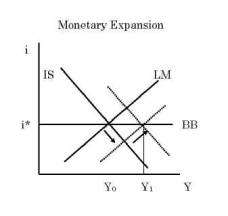INTERNATIONAL
ECONOMICS—FINAL EXAM
(3-4
pm, July 18, 2003)
Instructor:
Professor Kenichi Ohno
|
This is a closed book exam. Use your pen and brain
only.
PLEASE
WRITE CLEARLY. Poor handwriting will be
ignored, resulting in lost points.
ANSWER
ALL QUESTIONS. Use only TWO
official answer sheets. Use only FRONT side of each answer
sheet. Allocate space carefully.
Clear
and concise answers are preferred. Long answers do not guarantee high
points.
After
the exam, model answers will be distributed. Graded answer sheets will be
returned to the students a few days later and overall results will be
posted in the web. |
Answer
in any order; each question carries 20 points
Q1.
Assuming perfect capital mobility and a floating exchange rate, what does the
Mundell-Fleming model predict about the effectiveness of monetary policy?
Q2. Why did the Bretton
Woods exchange rate system collapse? Also discuss Triffin’s dilemma.
Q3.
What is a currency board ? What are its merits and demerits?
Q4.
Describe the empirical methodology used by G. Kaminsky, S. Lizondo and C.M.
Reinhart, “Leading Indicators of Currency Crises” (IMF Staff Papers,
March 1998—reading assignment (B)). In your opinion, can future currency
crises be predicted?
Q5.
Describe Kazakhstan’s response to the Russian crisis during 1998-99. How did
it differ from the crisis response of the East Asian economies during 1997-98?
Model
answers
(Other answers are often possible)
 Q1. Under the described situation, monetary policy is
very effective; it can raise income to a greater extent than under a
closed economy. A rightward shift of the LM curve lowers the domestic interest
rate, prompting a massive capital outflow and exchange rate depreciation.
Depreciation in turn stimulates net exports, shifting the IS curve to the right.
Since LM and IS both move to the right, income is doubly increased. [Optionally,
you can use a diagram to explain.]
Q1. Under the described situation, monetary policy is
very effective; it can raise income to a greater extent than under a
closed economy. A rightward shift of the LM curve lowers the domestic interest
rate, prompting a massive capital outflow and exchange rate depreciation.
Depreciation in turn stimulates net exports, shifting the IS curve to the right.
Since LM and IS both move to the right, income is doubly increased. [Optionally,
you can use a diagram to explain.]
Q2. The BW system came
to an end because the global nominal anchor (monetary discipline of the center
country) eroded. In the late 1960s, American monetary policy became expansionary
due to welfare cost, the war in Vietnam, space race with the USSR, etc. This
created domestic inflation and downward pressure on the dollar against gold as
well as other currencies. The gold-dollar link effectively ended in 1968 and
exchange parities collapsed in 1971-73. However, Triffin’s dilemma asserts
that the US cannot be blamed because it faced an impossible choice. To supply
global liquidity, it had to run a trade deficit. But to maintain confidence, it
must not run a trade deficit.
Q3.
A currency board is an arrangement where base money is issued only against the
equal holding of international reserves. In other words, the monetary authority
does not provide credit to the government or commercial banks. This removes its
discretionary power. The merits of the currency board include greater
credibility for convertibility and price stability. Its demerits are the loss of
monetary autonomy and the lack of “lender of last resort” function in the
event of a financial crisis.
Q4. A currency
crisis is defined as a combined depreciation and international reserve loss
beyond a certain threshold. The authors adopt the signals approach where
monthly indicators with high predictive power are selected and ranked.
Overvaluation, banking crises, exports, etc. are found to be such signals.
However, if currency attacks occur as a result of unstable market psychology
rather than poor fundamentals, economic variables may not be good predictors of
future crises. Furthermore, if many types of crisis exist, or if causes shift
over time, models based on past average may not work.
Q5.
Kazakhstan was severely hit by the Russian crisis through export price decline,
export market loss and surging imports. At first, the government adopted a
faster currency crawl, a bit tighter macro stance, and temporary trade and
capital controls. After several months, it finally gave up and floated the
tenge. As the floating began, various measures to soften the blow to the
consumers, banks and enterprises were taken (50% forex sale requirement,
incentive for not withdrawing tenge deposits, etc). Compared with East Asia’s
crisis, Kazakhstan’s response was remarkable in that (i) sharp macroeconomic
tightening was avoided; (ii) non-market defensive measures were taken; and (iii)
structural reform was not accelerated during the crisis.
 Q1. Under the described situation, monetary policy is
very effective; it can raise income to a greater extent than under a
closed economy. A rightward shift of the LM curve lowers the domestic interest
rate, prompting a massive capital outflow and exchange rate depreciation.
Depreciation in turn stimulates net exports, shifting the IS curve to the right.
Since LM and IS both move to the right, income is doubly increased. [Optionally,
you can use a diagram to explain.]
Q1. Under the described situation, monetary policy is
very effective; it can raise income to a greater extent than under a
closed economy. A rightward shift of the LM curve lowers the domestic interest
rate, prompting a massive capital outflow and exchange rate depreciation.
Depreciation in turn stimulates net exports, shifting the IS curve to the right.
Since LM and IS both move to the right, income is doubly increased. [Optionally,
you can use a diagram to explain.]